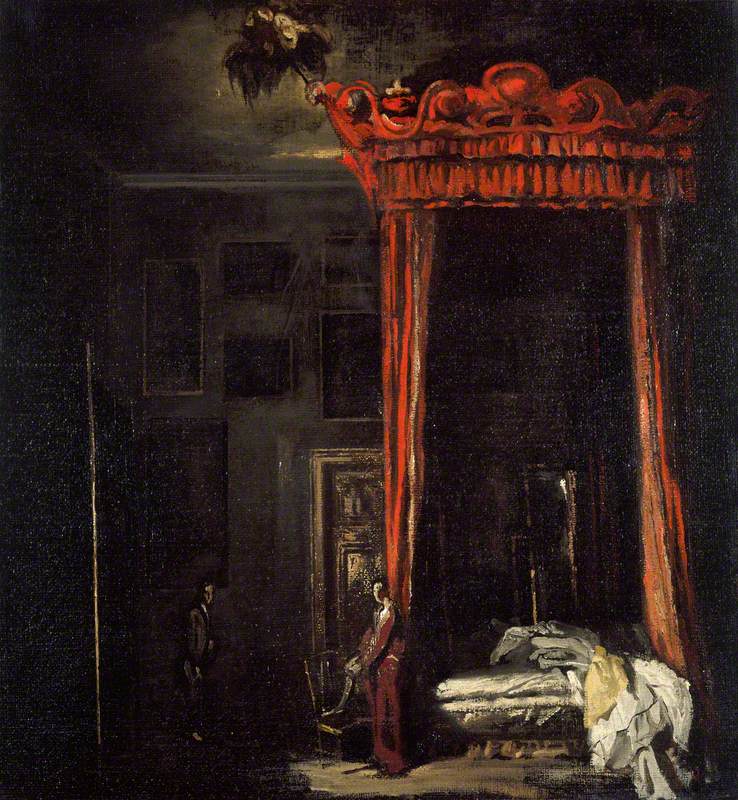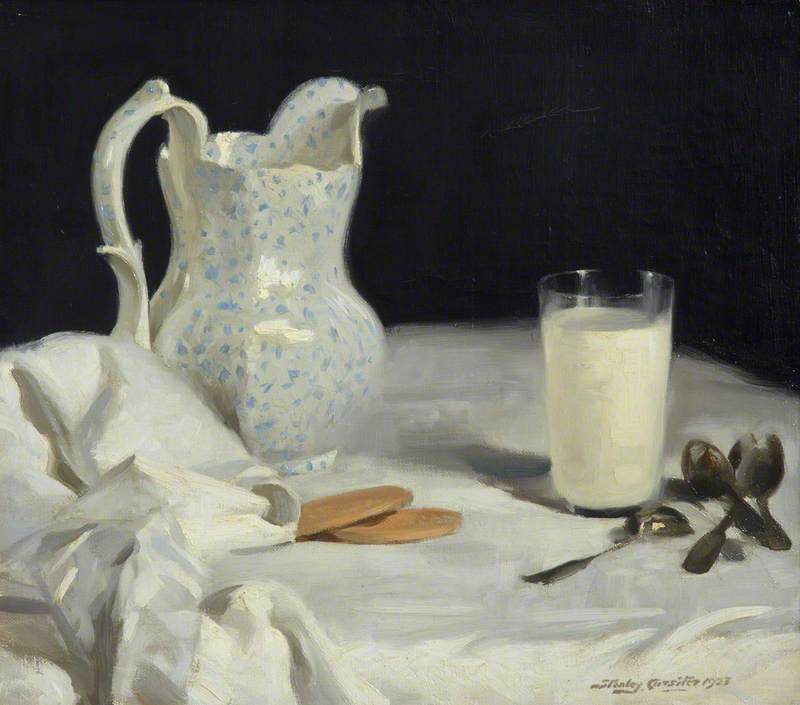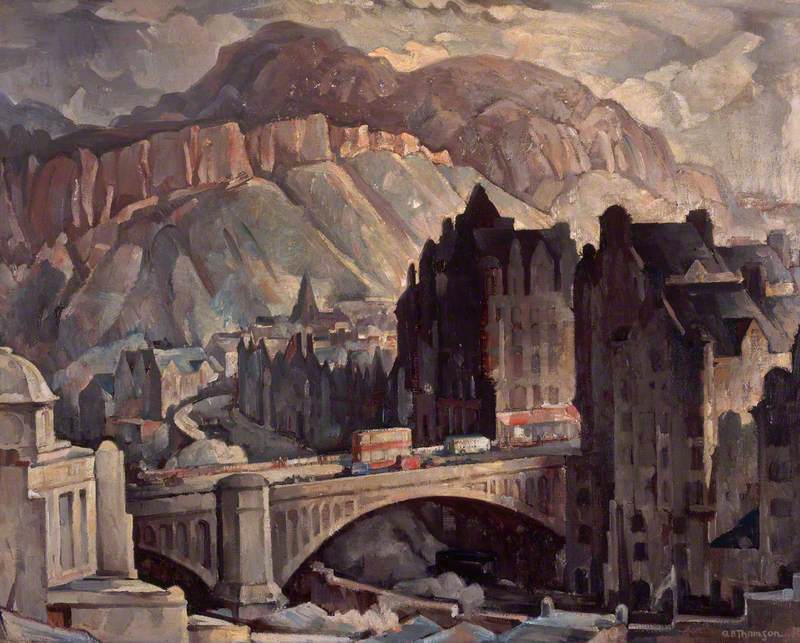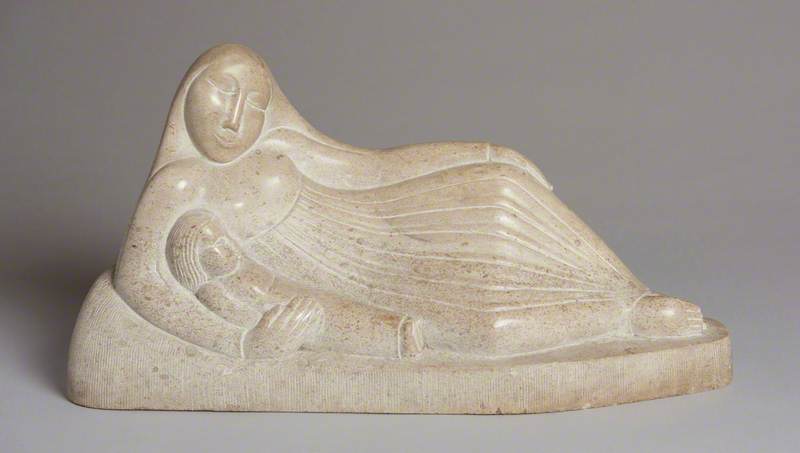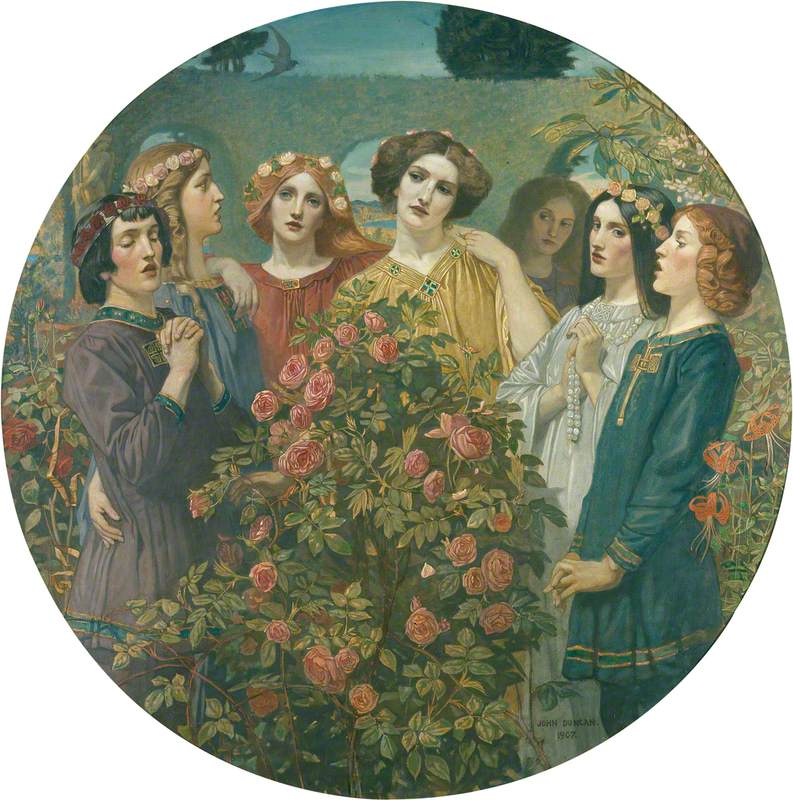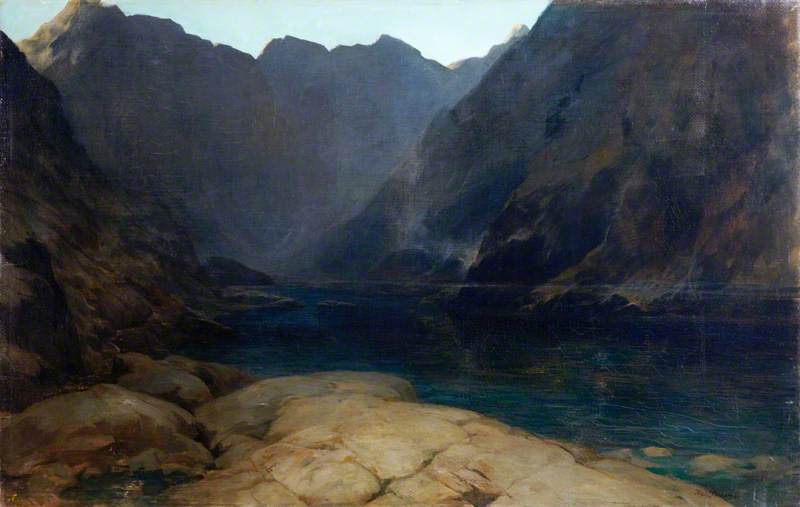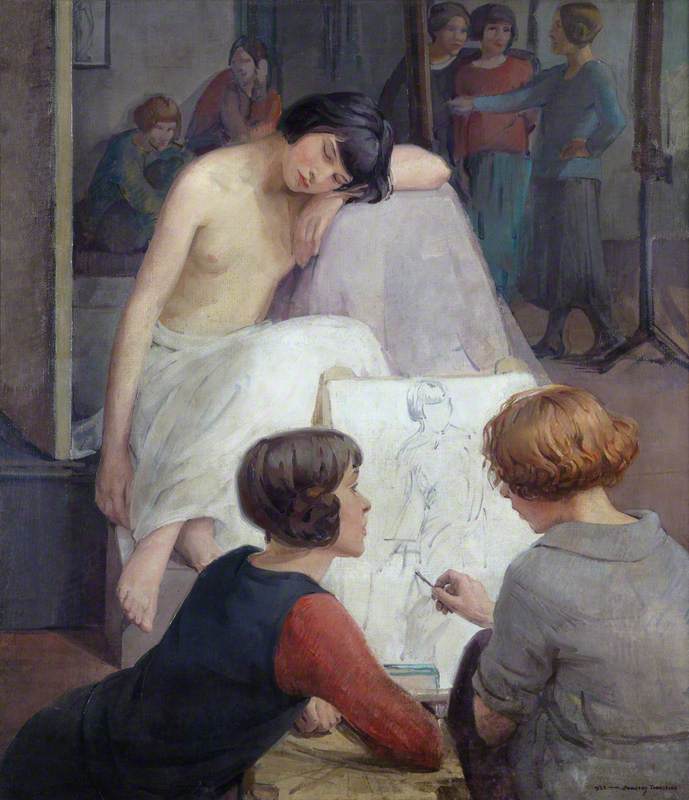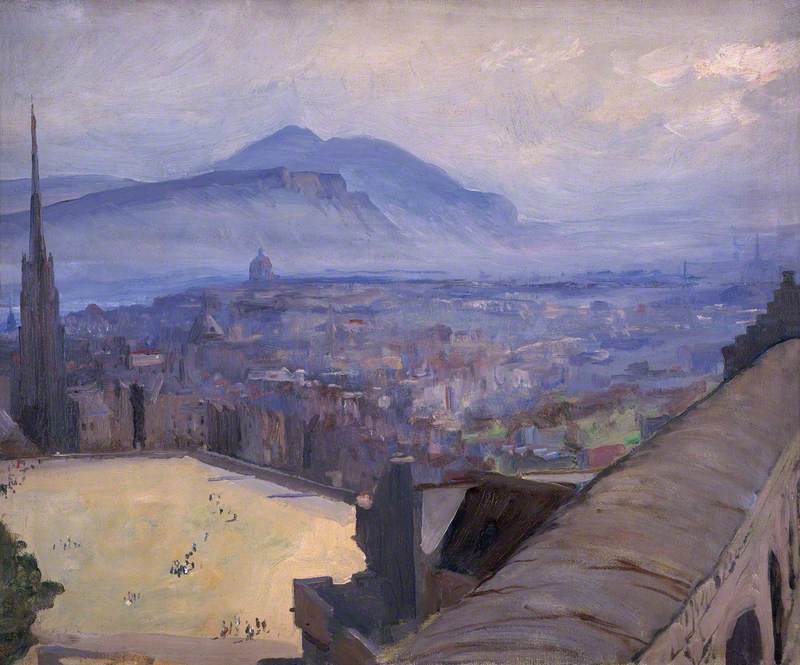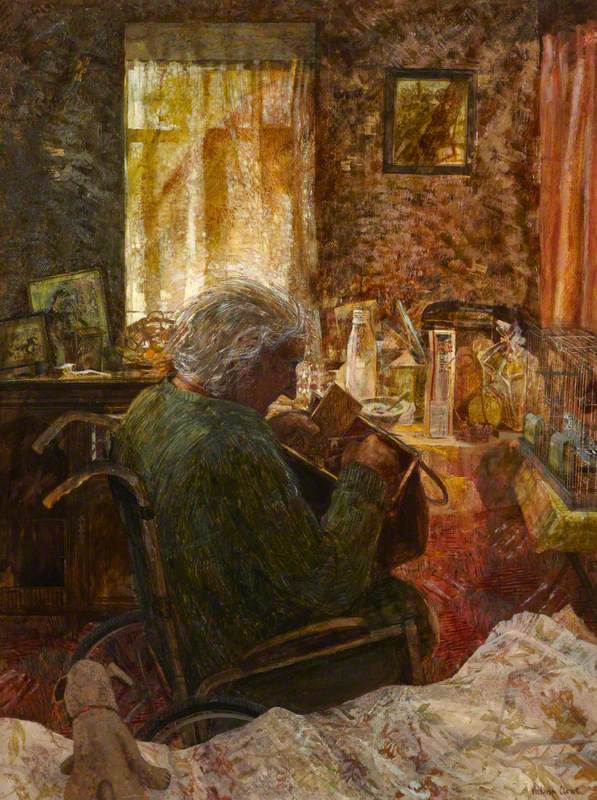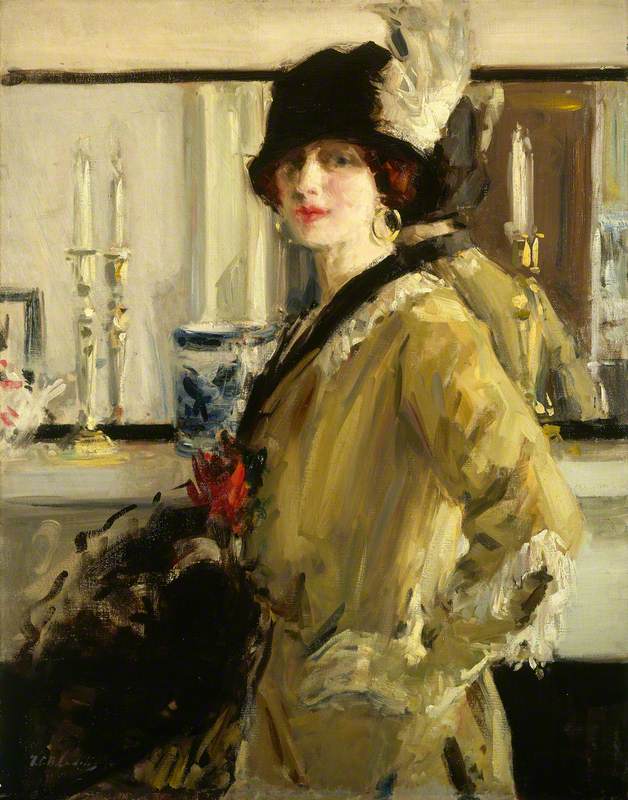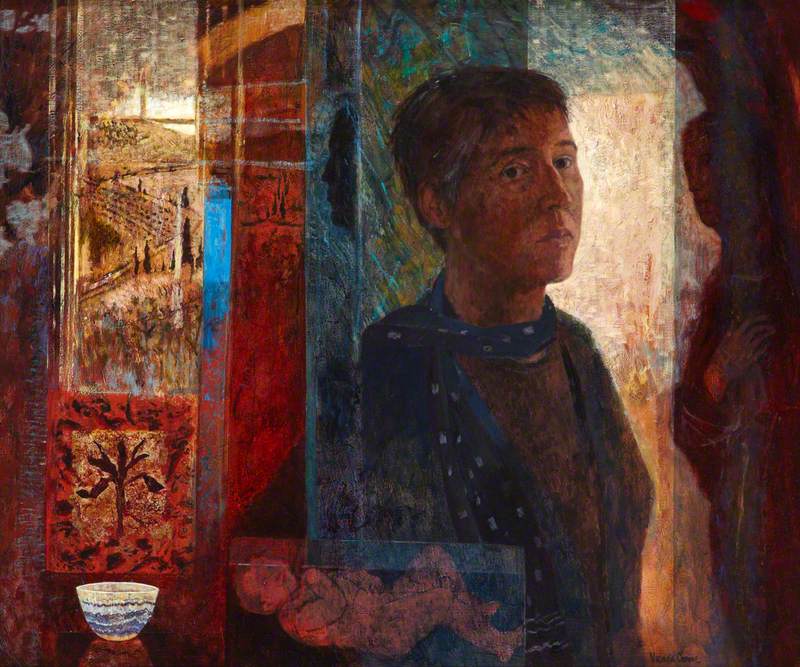Learning and Public Programmes Manager Margaret Findlay, and Events and Duty Manager Angela Hall have coordinated and created this exhibition representing the choices of our Front of House Staff at Museums & Galleries Edinburgh. The choices are very personal and showcase a variety of artworks. The choices represent our very valued front of house team, and many of them deliver tours and interpretation to our visitors. We are delighted to also include choices by our Culture and Communities Convener Cllr Donald Wilson and Vice Convener Cllr Amy McNeese-Mechan.
-
The Red Bed, James Ferrier Pryde (1866-1941)
The Red BedVictoria Fairlie
I love this painting because Pryde has created an atmosphere of foreboding and macabre despite the simple composition. This painting belongs to a series entitled ‘The Human Comedy’, each of which depicts an aspect of the human condition and is dominated by a bed. Beds were of interest to Pryde, who stated: “Look at what happens on it and how much of our time we spend on it.” The historical significance of beds – especially in relation to women – is summed up beautifully by Margret Atwood in her novel Alias Grace: “There are many dangerous things that may take place in a bed. It is where we are born, and that is our first peril in life; and it is where the woman gives birth, which is often their last.."
James Ferrier Pryde (1866–1941)
Oil on canvas
H 68 x W 62.9 cm
Museums & Galleries Edinburgh – City of Edinburgh Council
-
A Glass of Milk, Stanley Cursiter (1887–1976)
A Glass of Milk 1923Alice van de Ven
I love this painting because it’s a very light scene, in colour and topic. At first glance, there is just this explosion of white, but you start to discover different aspects when you take more time to look at the painting. The blue dots on the jug, the scrambling of the silver spoons and the dainty biscuits. It is difficult to portray texture and light with using just one predominant colour, so I am very impressed with Stanley taking this risk and still delivering this light-hearted piece. It portrays a time that does not really exist anymore, an innocence or unconsciousness of a time before modernization and globalisation. This jug could be something made by a local craftsman, the milk from a farmer.
Stanley Cursiter (1887–1976)
Oil on canvas
H 40.6 x W 45.7 cm
Museums & Galleries Edinburgh – City of Edinburgh Council
-
North Bridge and Salisbury Crags, Edinburgh, from the North West, Adam Bruce Thomson (1885–1976)
North Bridge and Salisbury Crags, Edinburgh, from the North WestMarie Bergstrom
I have chosen this painting because it shows how beautiful and majestic Edinburgh is, the mixture of civilisation and nature. A busy city with a lot of traffic on the North Bridge and high buildings. Then in the background we see the rugged Salisbury Crags surrounded by clouds. I love the purple colours, it makes the painting mysterious. The artist is Adam Bruce Thomson and he was born in Edinburgh in 1885. He studied at the Royal Institution School of Art and at the Edinburgh College of Art. Thomson is regarded as one of the Edinburgh School of artists. He is best known for his oil and watercolour landscape paintings, particularly of the Highlands and Edinburgh.
Adam Bruce Thomson (1885–1976)
Oil on canvas
H 109.2 x W 137.1 cm
Museums & Galleries Edinburgh – City of Edinburgh Council
-
Maternity, Thomas W. Whalen (1903–1975)
Maternity 1935Lynn Fulton
I love this piece, perhaps because I have an interest in 1930s sculpture and have long admired an architectural relief panel produced by the artist around the same time for Kilsyth Academy. I was delighted to discover ‘Maternity’, a small stylised stone sculpture which is captivating from every angle. This timeless sculpture beautifully depicts mother and infant in a minimalist style. It seems to me that the figure appears out of the stone without disturbing what was possibly the original form. This effect is similar to the work of the contemporary sculptor Ronald Rae, whose work I also enjoy greatly. The artist is said to have been influenced by the work of Eric Gill and that of medieval sculpture.
Thomas W. Whalen (1903–1975)
Hopetoun Wood stone
H 27.5 x W 50.8 x D 15.6 cm
Museums & Galleries Edinburgh – City of Edinburgh Council
-
Hymn to the Rose, John Duncan (1866–1945)
Hymn to the Rose 1907Paul Meadows
I love this painting because it tells an intriguing story of love, desire, obsession, possession and rejection. At first glance it looks like a beautifully painted, surreal scene of a group of people paying homage to a rose bush. Look closely at the dynamic of the various characters; their expressions, to whom they're gazing at and the position of their hands - particularly the woman in gold in the centre. Only the two in the foreground seem to be singing, oblivious to the emotional turmoil raging around them. Are they the cause of this turmoil? What about the outcast at the back? Why is she excluded? And what about the beautiful rose bush? Gloriously in full bloom, yet one of the blooms looks to have been destroyed. Whodunnit?
John Duncan (1866–1945)
Oil on canvas
H 122.2 x W 122.2 cm
Museums & Galleries Edinburgh – City of Edinburgh Council
-
Maule's Corner after Rain, Edinburgh, Robert Easton Stuart (1864–after 1939)
Maule's Corner after Rain, Edinburgh 1925Angela Hall
This is one of my favourite paintings in our collection - much loved by our visitors. I love how it evokes the romance and fashion of the 1920s. Maule's Corner was the spot where courting couples met under the clock. Robert Maule & Sons was described as "One of the largest and best-appointed drapery house furnishings and fashion emporiums in Scotland". Their catchphrase 'Meet me at Maules' became an instant hit and whether planning on shopping there that day or not, the corner became a popular meeting point for Edinburgh locals and the tradition of meeting there has endured until this very day.
Robert Easton Stuart (1864–1940)
Oil on canvas
H 71.1 x W 92 cm
Museums & Galleries Edinburgh – City of Edinburgh Council
-
The Valley of the Shadow, Loch Coruisk, Robert Burns (1869–1941)
The Valley of the Shadow, Loch Coruisk exhibited 1909Catriona Mowat
'The Valley of the Shadow, Loch Coruisk’ is one of my favourite artworks in our collection. The scene appears to be so tranquil, but Lock Coruisk in the Isle of Skye was called “the wildest place in the highlands” by Lord Tennyson and is the mythical home of a Kelpie: a shape shifting demonic water spirit, often depicted as a horse that would lure humans to drown. This painting says to me that you can never tell what is hiding beneath the surface. The use of colour in this painting has always caught my eye with the vivid blue of the water leaping out from the canvas. The detail in the stone makes me feel as if I were there. For me, this oil on canvas painting is the perfect idea of a classic Scottish landscape.
Robert Burns (1869–1941)
Oil on canvas
H 105.4 x W 161.3 cm
Museums & Galleries Edinburgh – City of Edinburgh Council
-
Cheap Rooms, David Pugh Evans (b.1942)
Cheap Rooms 1980Eva Vaporidi
I like this painting because of its ‘quiet’ tension and enigmatic atmosphere.
The dramatic interaction of light and shadow, the clear forms and lack of detail creates a three-dimensional-space-effect, highlighting a sense of distance and emptiness. Though the initial focus is on the figure, I realise that the space itself also has a powerful presence. The walls which surround him create a claustrophobic space and stillness, separating him from the outside world. Evans’ paintings are often still and ‘quiet’. His solitary figures seem to be adrift in their spaces and loneliness - lost, uncertain or disconnected. The rather ‘ordinary’ looking scene in Cheap Rooms produces a distinctly uneasy feeling within me.
David Pugh Evans (1942–2020)
Oil on canvas
H 152.3 x W 162.5 cm
Museums & Galleries Edinburgh – City of Edinburgh Council
-
Rest Time in the Life Class, Dorothy Johnstone (1892–1980)
Rest Time in the Life Class 1923Kathryn Irvine
I love this painting because it depicts the emerging freedom of female artists in the early twentieth century. At the time Johnstone painted Rest Time, women were being taken more seriously as professional artists and they were finally able to receive some of the same training as their male contemporaries. This included access to life classes. This painting captures a sense of female autonomy that is rarely seen in artwork by men. There is freedom in the women’s short hair and loose clothing. They are focused on the creation of their artwork. The central figure of this painting is the nude model. She has command of her body and is comfortable having it on display.
Dorothy Johnstone (1892–1980)
Oil on canvas
H 121.5 x W 106.2 cm
Museums & Galleries Edinburgh – City of Edinburgh Council
-
Causewayside, Edinburgh, Anne Redpath (1895–1965)
Causewayside, Edinburgh c.1950Keith Baxter
I love this painting because of its ability to convey Edinburgh both as an urban environment and simultaneously as a series of small communities. The slightly distorted aesthetic brings to mind subjective memories of Edinburgh’s areas and our tendency to remember only what we wish of these places, empty and beautiful and somehow abstract. Whenever I think of the winding streets, I only bring to mind certain elements that would have otherwise seemed unimportant at the time and yet they form the basis of my understanding when I imagine my experiences within the city. I find this painting perfectly captures our ability to note the smallest of details in the biggest of spaces.
Anne Redpath (1895–1965)
Oil on board
H 48.3 x W 58.4 cm
Museums & Galleries Edinburgh – City of Edinburgh Council
 © the artist's estate / Bridgeman Images. Image credit: Museums & Galleries Edinburgh – City of Edinburgh Council
© the artist's estate / Bridgeman Images. Image credit: Museums & Galleries Edinburgh – City of Edinburgh Council
-
Gamine, Dorothy Black (b.1963)
GamineAmy Muir
I love the colours in this portrait. “Gamine” means “attractively boyish” – the contrast of the model’s beautiful features, painted so delicately, with the loud femininity of her clothing is striking. Upon first glance, the floral pattern and the bright yellow background are obvious, but a closer look is required to make out the woman’s face. There’s probably a deep message in there somewhere.
Dorothy Black (b.1963)
Oil on canvas
H 182.9 x W 152.4 cm
Museums & Galleries Edinburgh – City of Edinburgh Council
-
View of Edinburgh from the Castle, John Lavery (1856–1941)
View of Edinburgh from the CastleLaura McVie
I love this painting because it shows everything that makes Edinburgh so iconic. From the spires and buildings, and the green spaces and classical buildings to the unmistakable sight of Arthur's Seat looming dramatically in the background. It could have been painted 200 years ago, yet it could have been painted just yesterday, as it has a timeless quality. The people are dwarfed by the sheer power of nature and the landscape.
"Edina! Scotia’s darling seat!”, Robert Burns
John Lavery (1856–1941)
Oil on canvas
H 63.5 x W 75.5 cm
Museums & Galleries Edinburgh – City of Edinburgh Council
-
The Last Portrait of Jenny Armstrong, Victoria Crowe (b.1945)
The Last Portrait of Jenny Armstrong 1986–1987Emma McCombie
I love this painting because it shows us what feels like a very private moment. This painting is part of a wider series that shows Jenny when she could be outdoors working as a shepherd, so to see her confined to a small dark room in her house is very moving to me. When I look at this painting, I wonder what Jenny was fishing out her bag for the painter and what they talked about. I then take a look at the chaos of the room around Jenny; the birds, the uneaten food and the curtains drawn. Victoria Crowe’s work finds beauty, passion and energy in scenes that otherwise may have felt sad or stagnant.
Victoria Crowe (b.1945)
Oil on board
H 122 x W 91.5 cm
Museums & Galleries Edinburgh – City of Edinburgh Council
-
Tristan and Isolde, John Duncan (1866–1945)
Tristan and Isolde 1912Margaret Findlay
The legend of Tristan and Isolde is the tragic tale of two lovers fated to share a forbidden but undying love. Scholars of mythology believe that the legend originated in Brittany, western France. In time it was associated with the Arthurian legends and became part of the mythology of medieval Europe, told and retold in various versions and in many languages. As our Learning Manager I love this painting because of the numerous ways to interpret it - it offers possibilities in storytelling, poetry, creative writing, design, colour workshops, collage, costume design... the list is endless. Just look at these Celtic designs in the clothes! Over the years it has been a firm favourite with our visitors and schools.
John Duncan (1866–1945)
Tempera on canvas
H 76.6 x W 76.6 cm
Museums & Galleries Edinburgh – City of Edinburgh Council
-
The Black Hat, Francis Campbell Boileau Cadell (1883–1937)
The Black Hat 1914Cllr Donald Wilson
I thoroughly enjoyed revisiting the collection and struggled to choose just one. However, the one that jumped out to me was 'The Black Hat' by Francis Campbell Boileau Cadell. Not only for its style - I enjoy work by the Scottish Colourists, the impressionistic manner and 1920s style, but also for what it reminds me of. During my time as Lord Provost I had the pleasure of having the painting on display in the Lady Provost’s room in the City Chambers. It was greatly admired by my wife and I and suited both its location and our personalities. When I look at this painting it reminds me of my time as Lord Provost and all the great work achieved in the room, witnessed by the charismatic lady in the black hat.
Francis Campbell Boileau Cadell (1883–1937)
Oil on canvas
H 107 x W 84.5 cm
Museums & Galleries Edinburgh – City of Edinburgh Council
-
Italian Reflections, Victoria Crowe (b.1945)
Italian Reflections 1992–1993Cllr Amy McNeese-Mechan
Being asked to choose a favourite from our City Art Centre, an impossible task! I decided on Victoria Crowe, but which work to choose when I love them all, particularly her glowing snowscapes and dusk-lit woods, with that liminal Celtic betwixt and between light, very ‘brillig’, as Lewis Caroll might say. For me, her work evokes everything from Japanese painted screens to Byzantine triptychs to Renaissance frescoes. But Italian Reflections (1993), painted on her first trip to Italy, contains so many elements I love: the drenched jewel-like colours, the mysterious framed view of a winding road lined with those Tuscan poplars. You can relax from the heat in that cool shaded room, or go on a journey along that road.
Victoria Crowe (b.1945)
Oil on board
H 76.2 x W 91.5 cm
Museums & Galleries Edinburgh – City of Edinburgh Council
Explore artists in this Curation
View all 14-
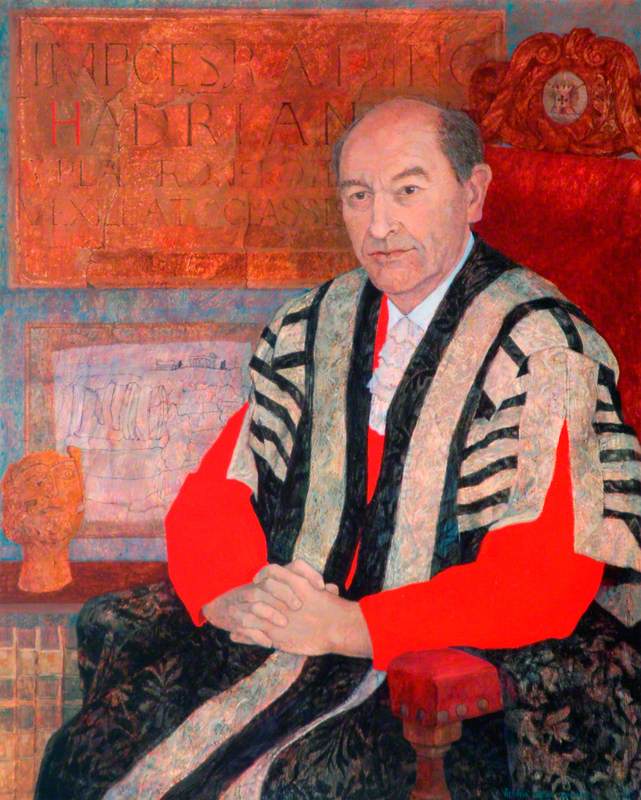 Victoria Crowe (b.1945)
Victoria Crowe (b.1945) -
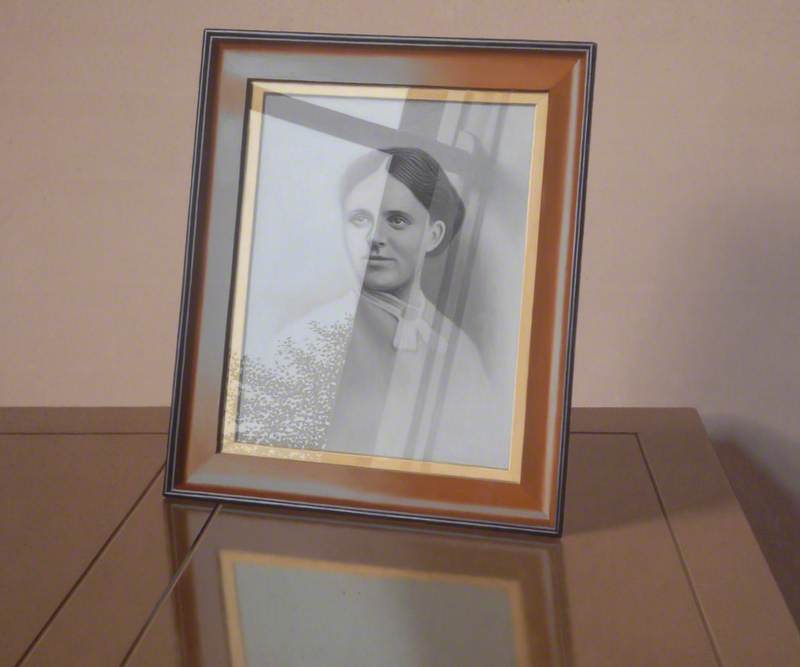 David Pugh Evans (1942–2020)
David Pugh Evans (1942–2020) -
 Robert Burns (1869–1941)
Robert Burns (1869–1941) -
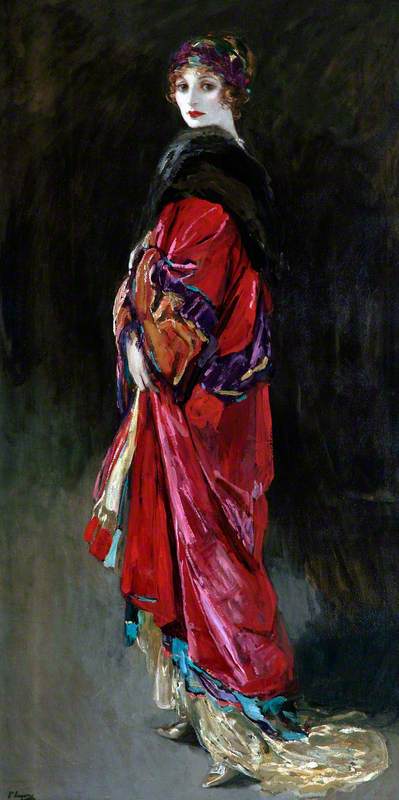 John Lavery (1856–1941)
John Lavery (1856–1941) -
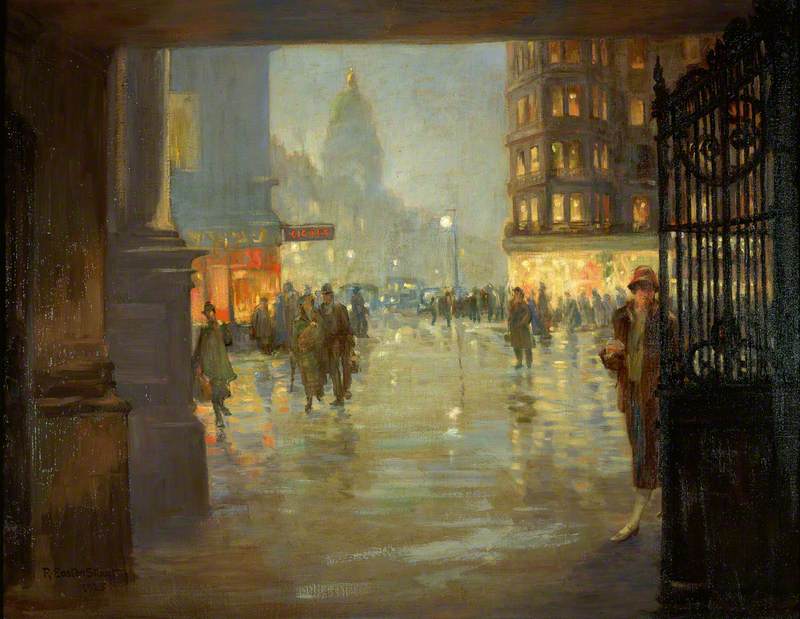 Robert Easton Stuart (1864–1940)
Robert Easton Stuart (1864–1940) -
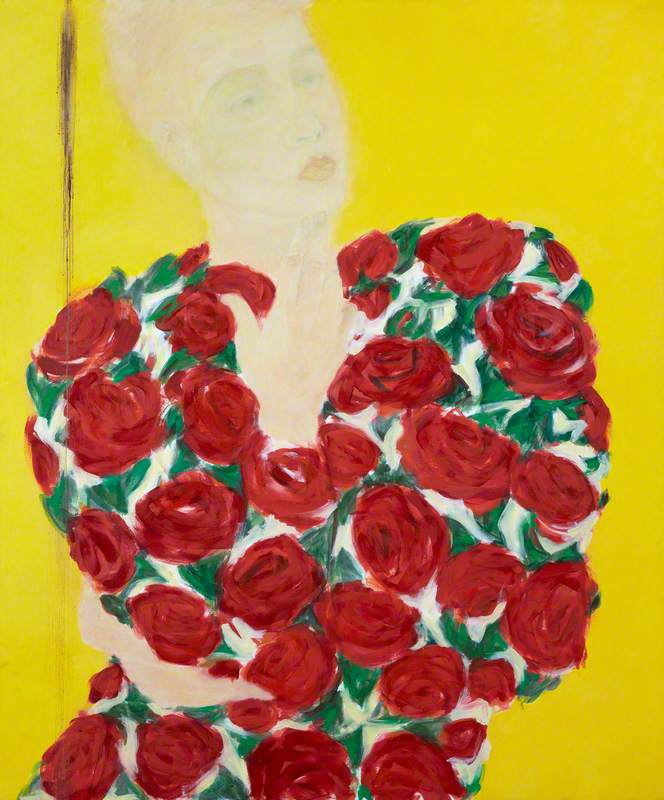 Dorothy Black (b.1963)
Dorothy Black (b.1963) -
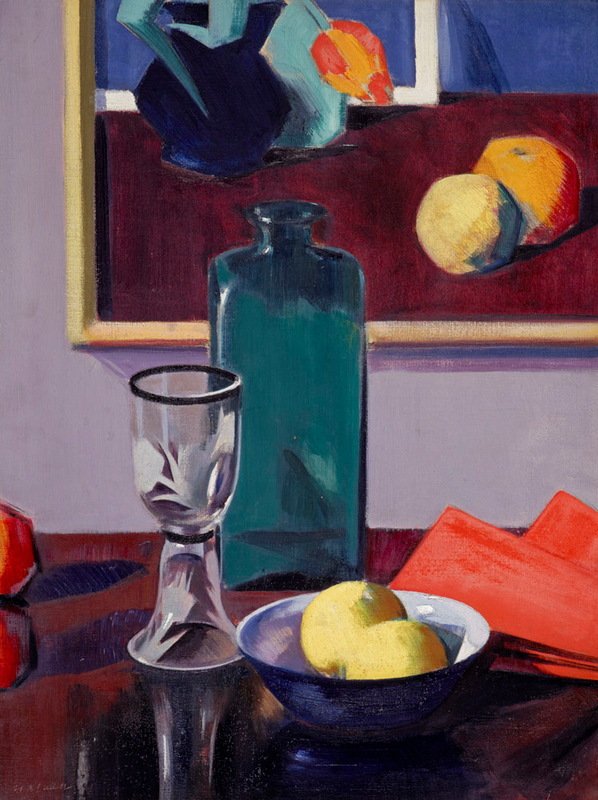 Francis Campbell Boileau Cadell (1883–1937)
Francis Campbell Boileau Cadell (1883–1937) -
 Stanley Cursiter (1887–1976)
Stanley Cursiter (1887–1976) -
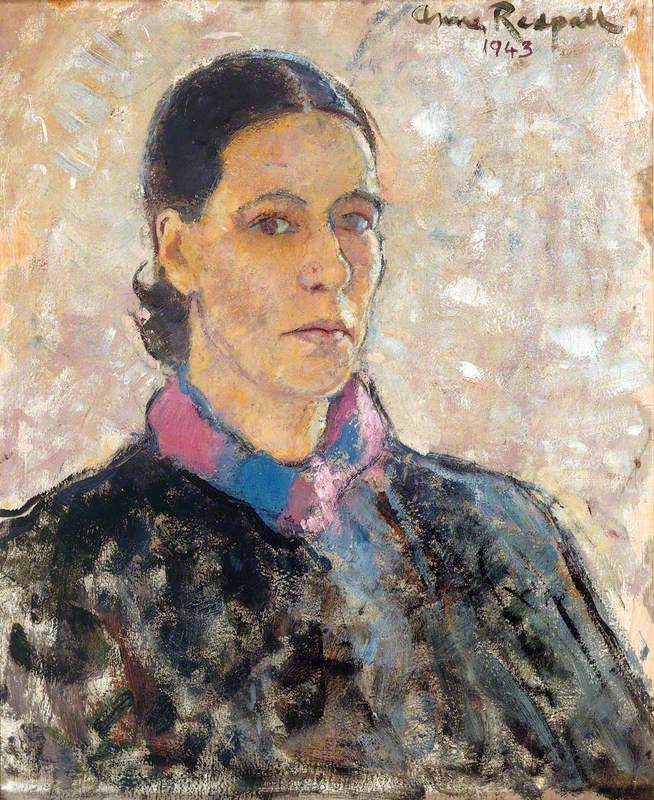 Anne Redpath (1895–1965)
Anne Redpath (1895–1965) -
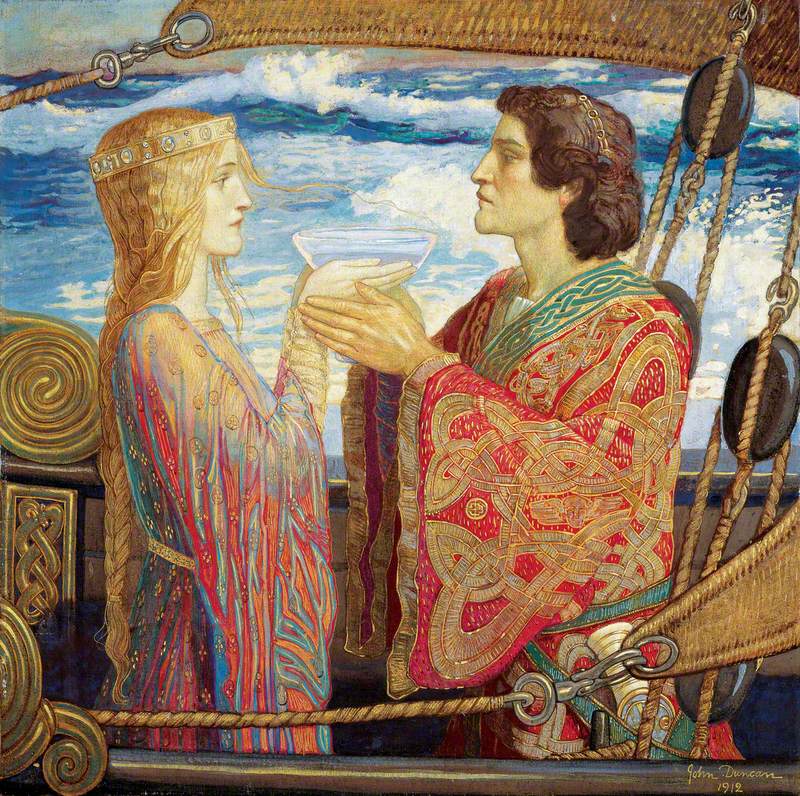 John Duncan (1866–1945)
John Duncan (1866–1945) - View all 14
